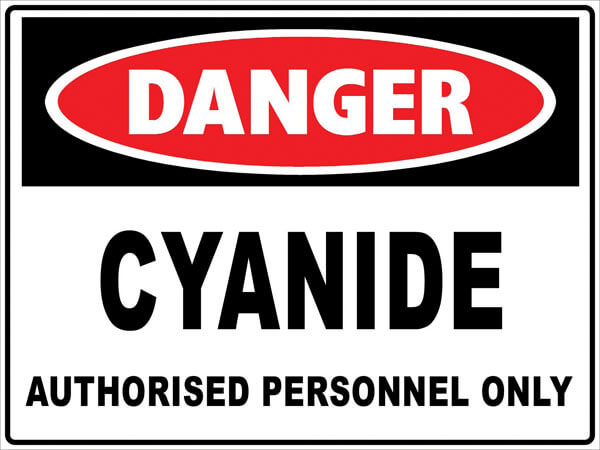The addition of gold or silver to an alkaline sodium cyanide solution will cause the gold and silver to react with the cyanide and dissolve into the solution in a process called cyanidation. This process is more frequently referred to as leaching. As well as reacting with the precious metals, the cyanide will react with iron, copper or zinc that may be in the ore. In order to leach the precious metals efficiently, the following leaching conditions must exist:
- Excess residual cyanide. More than enough cyanide than what is required to dissolve the gold and silver.
- Enough air and therefore oxygen in the leaching solution to react with the cyanide and the gold and silver.
- High pH or “protective alkalinity” to prevent the generation of lethal hydrogen cyanide gas.
- Sufficient time for the cyanide and oxygen to react with the gold and silver.
Since cyanide reacts with the gold and silver, it is consumed during leaching. The cyanide can and will also react with other undesirable metals and is essentially wasted. Therefore, if excess cyanide is not added to the leach circuit, the amount of available or free cyanide’ decreases, limiting gold and silver dissolution. For this reason, free cyanide is added continuously at the ball mill and the first leach tank to compensate for the cyanide that is consumed.
As well as reacting with the gold, silver, and other metals in the ore, cyanide will react preferentially with water in an environment of a pH less than about 10, and form Hydrogen Cyanide (HCN), a dangerous and potentially lethal gas. Refer to Section on the hazards of sodium cyanide. Therefore, a high pH or protective alkalinity of the slurry must be maintained to prevent the production of this dangerous gas. It should be noted however, that while a protective alkalinity is necessary, an excessively high alkalinity will hinder gold and silver dissolution. Therefore, the pH of the leach slurry must be maintained between 10.0 and 11.0.
For the leaching reaction to occur, oxygen must be dissolved into solution. Like cyanide, oxygen is consumed in the leaching reaction and must therefore be replaced continuously throughout the circuit.
Although the reaction between cyanide and gold or silver occurs instantaneously, time is required for the gold and silver to come in contact with the cyanide and be dissolved into solution. It should be noted that gold and silver dissolution rates differ; the silver requiring a much longer retention time, the Argentite circuit exists for this reason.
The chemical reaction that governs the solubility of gold and silver during leaching are as follows:
4Au + 8NaCN + 02 + 2H20 > 4Na
[Au(CN)2] + 4NaOH
and
4Ag + 8NaCN + 02 + 2H20 > 4Na[Ag(CN)2] + 4NaOH
Free cyanide and dissolved oxygen are critical for this reaction.
In our particular EXAMPLE process the leaching actually begins in the ball mill, where sodium cyanide, in the form of barren solution, in addition to a 20% sodium cyanide solution, is added to the ball mill feed. Oxygen must also be dissolved into solution and violent agitation is necessary for the reaction to occur. The ball mill provides this initial aeration and agitation. The four leaching tanks are designed to further the leaching process by the addition of fresh sodium cyanide, air, and violent agitation. A certain amount of retention time is also required for gold dissolution. The discharge from the last leach tank goes to the Primary Filtration Circuit.
The Cyanide Leaching Circuit is designed to the following criteria:
Leach Slurry Density: 45% solids
Slurry pH: 11.0
Cyanide Concentration: 0.5 gm/litre
Cyanide Consumption: 0.7 kg/tonne of ore
Lime Consumption: 2.15 kg/tonne of ore
The product from the last leach tank contains approximately 45% solids. About 95% of the gold and 36% of the silver in the ore will have been dissolved and a significant portion of this is in the solution phase of the pulp from the leach circuit.
Sodium Cyanide: Reagent Mixing System
The sodium cyanide mixing system prepares a 20% sodium cyanide solution for delivery to the process. The mixing system consists of a mix tank and a day tank located on the basement floor in the grinding area. The cyanide mixing area is curbed and a dedicated sump pump serves the area to pump any spillage into the cyanide mix tank. The 2 meter diam. x 2.5 meter high covered and ventilated mix tank is equipped with a 3 HP agitator. The mix tank is fitted with a one ton cyanide bag breaking hopper (or a 1350 kg cyanide flow bin) and a pressure gauge to indicate solution level. Reclaim water is used to prepare the cyanide solution. A locally controlled, panel stopped, vent fan exhausts all gases generated inside the tank. An HCN probe located near the mix tank will alarm at the mill control panel annunciator should the HCN concentration reach 30 ppm. A 2 HP 3″ x 1-1/2″ transfer pump delivers the mixed cyanide to a day tank. A recirculation line prior to the day tank allows flow back into the mix tank. A level gauge glass, low level switch and alarm are provided on the day tank for monitoring the solution level in the mix tank and to alarm a low cyanide solution level. An overflow line from the day tank will permit any overflow solution to flow back to the mix tank. This system is equipped with four 1/4 HP metering pumps which individually deliver the mixed sodium cyanide solution (at 20%) to each feed point in the process.
https://www.911metallurgist.com/thickener-startup-shutdown-procedure
https://www.911metallurgist.com/leaching-circuit-operation-startup-and-shutdown-procedure
